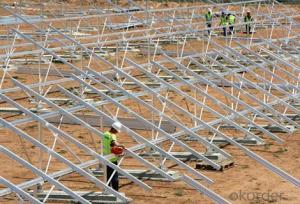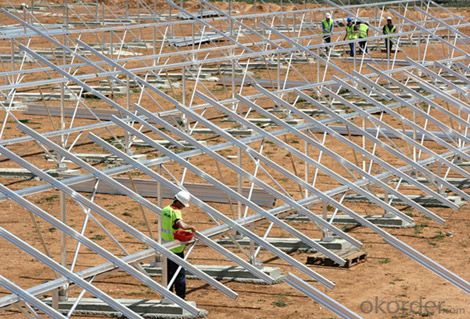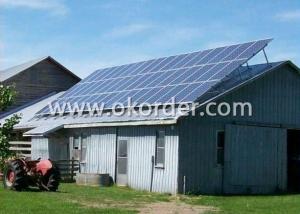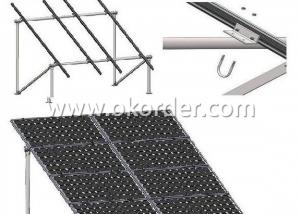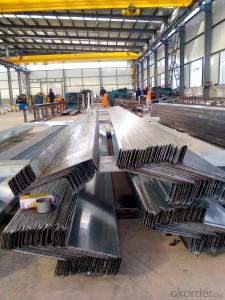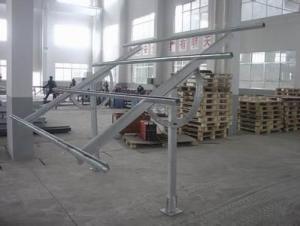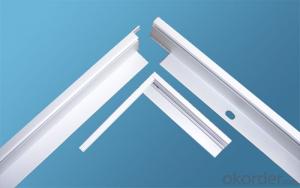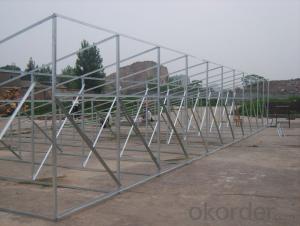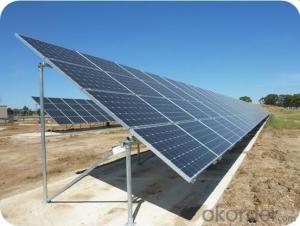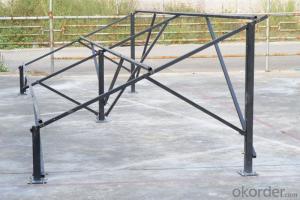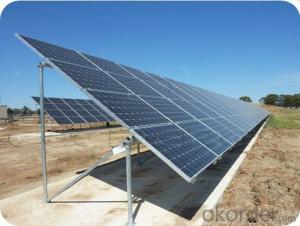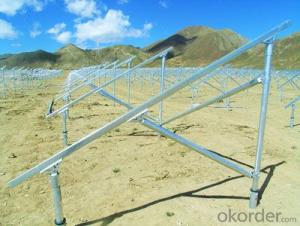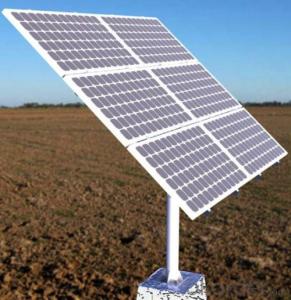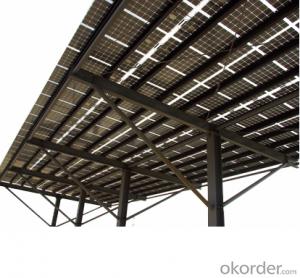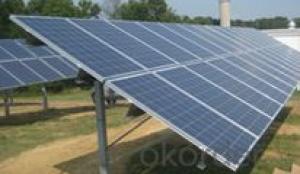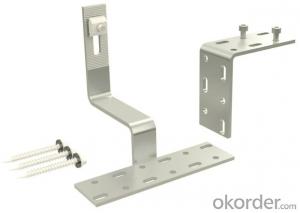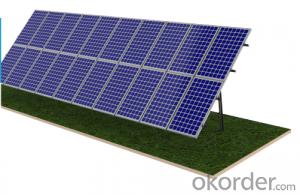Rv Solar Mounting Systems - Solar Panel Mounting System TT-TK-02
- Loading Port:
- Shanghai
- Payment Terms:
- TT OR LC
- Min Order Qty:
- -
- Supply Capability:
- 50万套 set/month
OKorder Service Pledge
OKorder Financial Service
You Might Also Like
PV Mounting brackets are special solar photovoltaic systemfor placing, installing, fixing the solar panel design. Generally materials arealuminum, steel structure, stainless steel. PV mounting products at groundmounting system, flat roof mounting system, adjustable angle roof rack system,inclined roof rack system, column bracket system.
The Ground Mounting System including concret basement sysytemand steel pipe sysytem, Titanergy provides total solution for flat or pitchedroof with patent products.On the basis of the given project data, specificnational standards and guidelines, Titanergy will calculate the completestructural analysis and create a complete project plan to make sure reliablestructural safety.We provide high quality HDG steel and aluminum products forthe ground mounting sysytem,witch can make sure the security and durability ofthe project.
Features and Advantages
n The rail bracket is easy to install, just use simple tools(eg, Allen wrench) can be easily installed. Rail connecting member can freelyadjust the length, the stent may be pre-installed on the roof, and thenappropriately adjusted according to the size of the solar panel.
n The combination of strong, aluminum rails and card blocks fora variety of venues and a variety of materials roofs (such as metal, ceramicand other kinds of tile surface)
n Component compatibility, and rail can meet PV modules fromdifferent manufacturers.
n accuracy, the length of the rail to the nearest millimeter,the construction process, not because of the length is too long or too shortfor the second cut.
n flexible assembly, rail hooks can adjust the spacing modulearray and tile has been installed successfully address the uneven roofconstruction led to difficult problems.
n design standards, product design and development process instrict accordance with GB, the German standards and other internationalstandards to ensure products reach the world advanced level.
n Quality assurance, the stent main material is high-qualityaluminum and stainless steel, effectively prevent corrosion of oxidation.Products can be recycled, reducing environmental pollution.
n Carried out strictly according to the current specificnational standards
n Perfectly optimized components and complete structuralanalysis for the sysytem
n High corrosion resisitance ensure the stability and highdurability
n Total test and certification make sure the high quality ofthe products
n Maximum pre-assembled in factory,quick mounting onsite,timesaving
10-year durability warranty
Technical Data
n Design Period:25 years
n Installation Site: Open area
n Array Angle:10°~60°
n ModuleType:Framed or unframed
n Material:Q235B,Al 6063-T5,Al 6005-T5,StainlessSteel A2-70
n Coating:HDG/Anodised
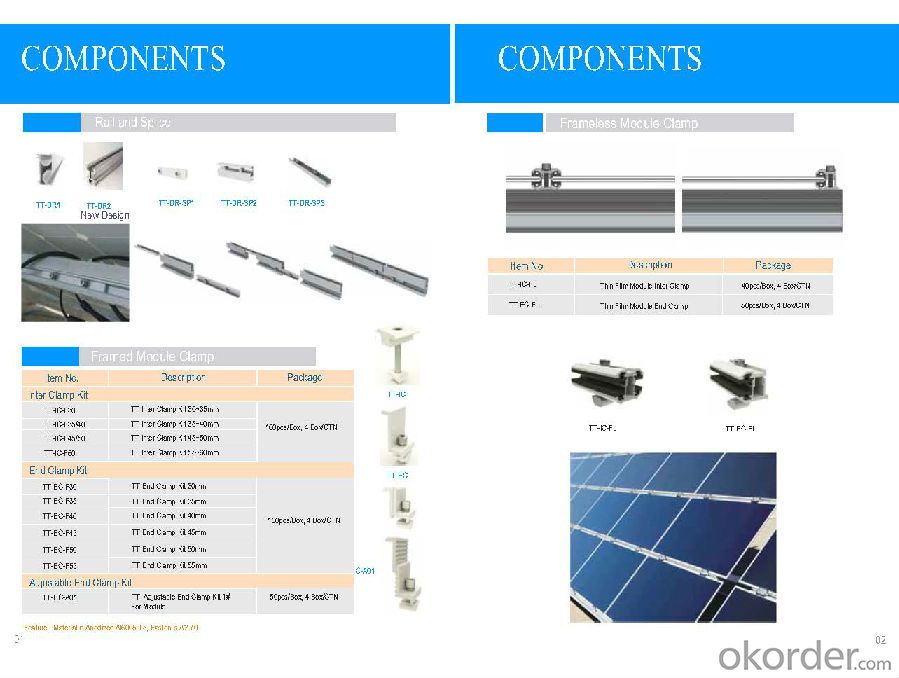
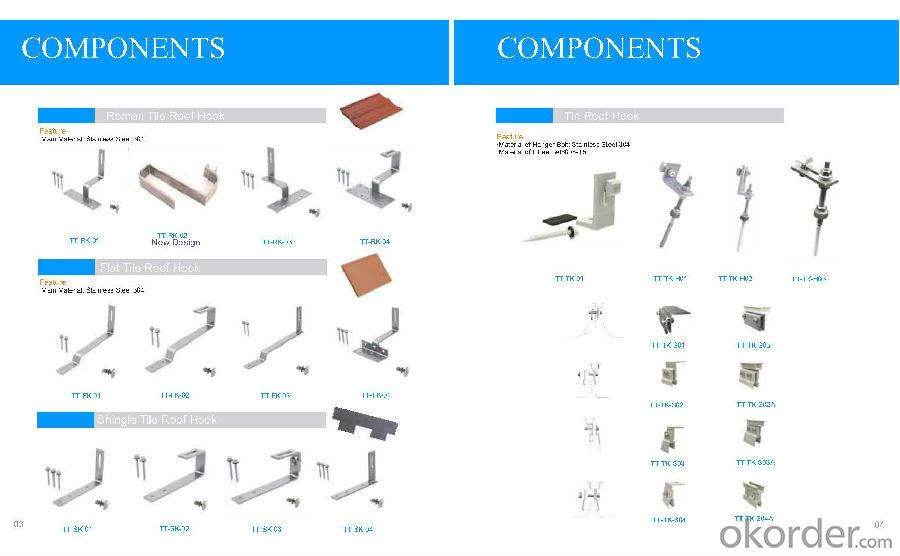
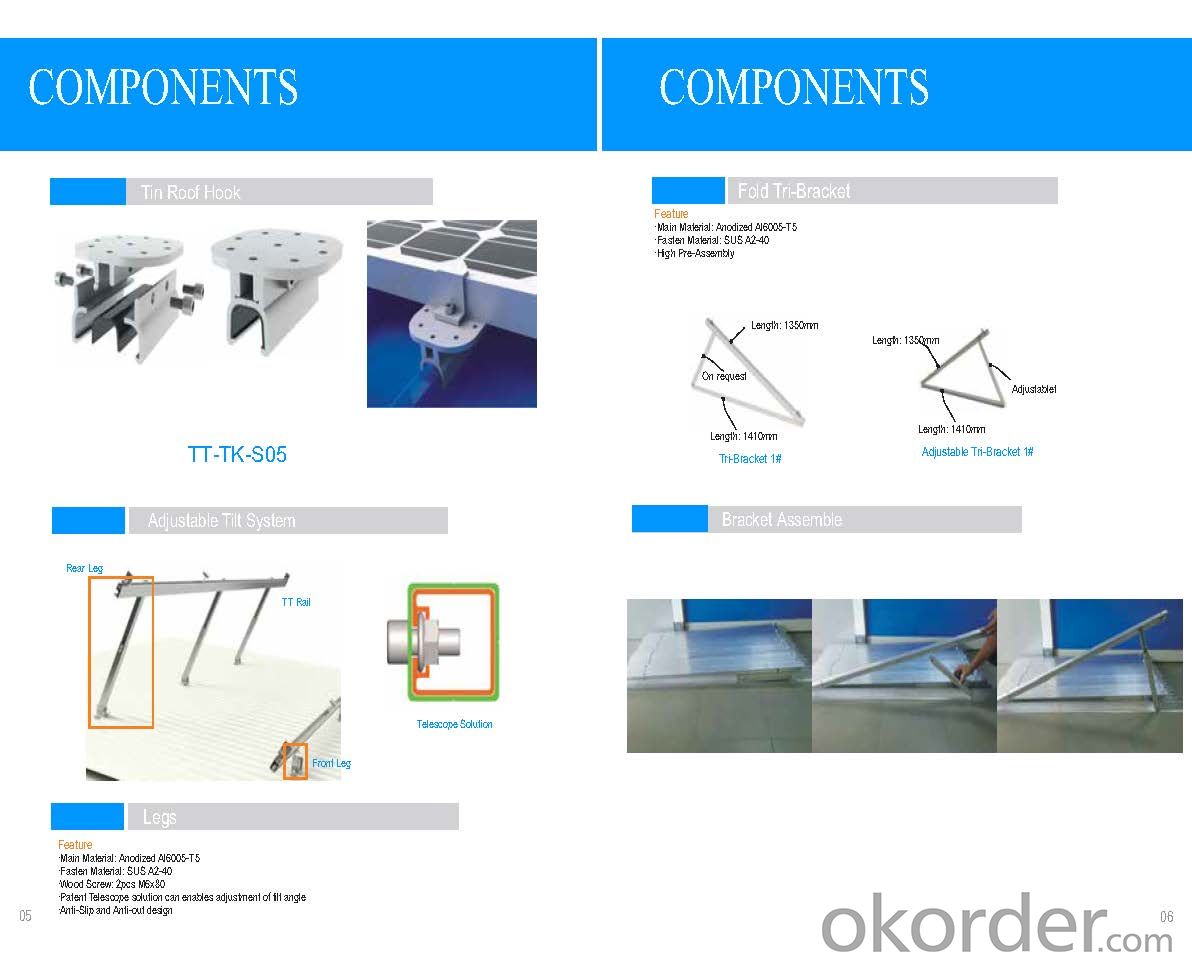
- Q: Can a solar mounting system be installed on a rooftop with a membrane roof?
- Yes, a solar mounting system can be installed on a rooftop with a membrane roof. However, it requires careful planning and expertise to ensure that the installation does not damage or compromise the integrity of the roof. Specialized mounting brackets and techniques are used to secure the solar panels without penetrating the roof membrane, minimizing the risk of leaks or other roof-related issues.
- Q: Are there any specific requirements for installing a solar mounting system on a rooftop with rooftop safety rails?
- Yes, when installing a solar mounting system on a rooftop with rooftop safety rails, there are specific requirements that need to be considered. These requirements typically include ensuring that the mounting system is compatible with the existing safety rails and does not compromise their structural integrity. Additionally, the solar mounting system should be installed in such a way that it does not obstruct access to the safety rails or impede their functionality. Proper coordination between the solar installer and the safety rail manufacturer or installer is crucial to ensure a safe and efficient installation.
- Q: What are the advantages of using a ground-mounted solar system?
- There are several advantages to using a ground-mounted solar system. Firstly, ground-mounted solar panels can be placed at the most optimal angle and orientation to maximize sunlight exposure, resulting in increased energy production. Additionally, ground-mounted systems allow for easier maintenance and cleaning, as they are more accessible compared to rooftop installations. They also offer flexibility in terms of scaling up the system size, making it easier to meet increasing energy demands. Furthermore, ground-mounted solar systems do not require any structural modifications to the roof, minimizing potential damage or leaks. Lastly, ground-mounted systems can be installed in various locations, including shaded areas, which may not be suitable for rooftop installations, thereby expanding the options for solar energy generation.
- Q: Can solar mounting systems be integrated with existing structures?
- Yes, solar mounting systems can be integrated with existing structures. There are various types of solar mounting systems available that can be easily retrofitted onto rooftops, facades, or open spaces of existing buildings. These systems are designed to be adaptable and compatible with different types of structures, allowing for seamless integration of solar panels without major modifications to the existing building.
- Q: Can a solar mounting system be installed on a summer camp or outdoor education center?
- Yes, a solar mounting system can be installed on a summer camp or outdoor education center. In fact, it can be a great addition to these facilities as it allows for the utilization of renewable energy sources, reducing reliance on conventional energy sources and promoting sustainability. The solar panels can be installed on rooftops, canopies, or ground-mounted systems, depending on the available space and specific requirements of the camp or education center. This installation can not only help to lower energy costs but also serve as an educational tool, teaching campers and visitors about the benefits of solar energy and the importance of environmental conservation.
- Q: How is a solar mounting system installed?
- A solar mounting system is typically installed by first securing the mounting structures to the roof or ground using appropriate fasteners. Then, the solar panels are attached to the mounting structures using clamps or brackets. The system is connected to the electrical wiring of the property, allowing the generated solar power to be used or fed back into the grid. Finally, the system is tested to ensure proper functionality and safety measures are in place.
- Q: What is the difference between a fixed tilt and a tracking solar mounting system?
- A fixed tilt solar mounting system is stationary and immobile, with solar panels set at a fixed angle that is optimized for the specific location's latitude. On the other hand, a tracking solar mounting system allows the solar panels to move and follow the sun's path throughout the day, maximizing the amount of sunlight captured. This tracking system can be either single-axis, which moves the panels in one direction (usually east-west), or dual-axis, which adjusts the panel's tilt and direction to track the sun's movement more precisely. Overall, tracking systems tend to generate more electricity but are also more complex and costly to install and maintain compared to fixed tilt systems.
- Q: Can a solar mounting system be used with solar concentrators?
- Yes, a solar mounting system can be used with solar concentrators. The mounting system is designed to securely hold and position solar panels, and it can be adapted to accommodate solar concentrators as well. This ensures that the concentrators are properly aligned and positioned to maximize the collection of solar energy.
- Q: What is the expected maintenance schedule for a solar mounting system?
- The expected maintenance schedule for a solar mounting system may vary depending on factors such as the type of system, location, and environmental conditions. However, in general, solar mounting systems typically require minimal maintenance. Routine inspections to ensure the integrity of the system, such as checking for loose or damaged components, may be recommended annually or biannually. Additionally, regular cleaning of the solar panels to remove dirt, debris, and any potential shading obstructions is advisable to optimize performance. Overall, a well-designed and properly installed solar mounting system should have a relatively low maintenance requirement.
- Q: Can a solar mounting system be used with different panel sizes?
- Yes, a solar mounting system can typically be used with different panel sizes. Most mounting systems are designed to be adjustable and versatile, allowing for various panel sizes and configurations. However, it is important to ensure that the chosen mounting system is compatible with the specific panel sizes you intend to use.
Send your message to us
Rv Solar Mounting Systems - Solar Panel Mounting System TT-TK-02
- Loading Port:
- Shanghai
- Payment Terms:
- TT OR LC
- Min Order Qty:
- -
- Supply Capability:
- 50万套 set/month
OKorder Service Pledge
OKorder Financial Service
Similar products
Hot products
Hot Searches
Related keywords
